Super Bowl LVI: How SoFi Stadium Is Powered By Cisco And Integrator AmpThink
The new $5.5 billion arena is loaded up with state-of-the-art wireless, video, and networking technology that will power its biggest event yet this week: Super Bowl LVI featuring its very own home team, the Los Angeles Rams.
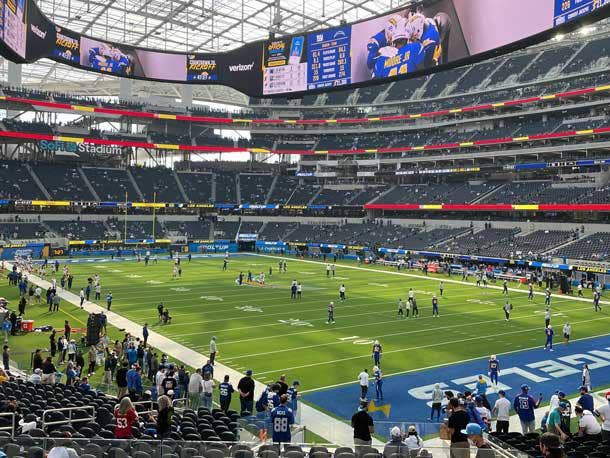
‘A Leap Of Faith And A Lot Of Collaboration’
SoFi Stadium, the home to both the Los Angeles Chargers and the Los Angeles Rams, is a next-generation sports and entertainment destination built with no expense spared at a cool $5.5 billion that opened in 2020.
Open-air SoFi Stadium is the first indoor-outdoor stadium to be constructed and the largest stadium in the NFL with a seating capacity of approximately 70,000 and is expandable up to 100,000 seats. It features 260 luxury suites and more than 13,000 premium seats.
It’s also a full-stack Cisco building, which means every piece of data running through the stadium touches a piece of Cisco gear — including video, audio, data center networking, and Wi-Fi. The massive deployment required not only a first-class networking vendor with an eye to the future, but a channel partner with specialized skills to handle massive IT deployments and powerful networking capabilities. That led Skarpi Hedinsson, CTO of SoFi Stadium and Hollywood Park, to Cisco and Ampthink, a Garland, Texas-based technology integrator.
Cisco, now an official technology partner of the NFL, joined forces with Ampthink which has made a name for itself handling IT and wireless deployments for some of the biggest arenas and stadiums in the U.S. Ampthink‘s CEO Bill Anderson called the project — the firm’s largest IT integration job to date — “a leap of faith and a lot of collaboration.”
“I’ve worked on some big projects with some crazy stuff, but I really believe that [SoFi] is kind of an unparalleled project,” Anderson said. “From that perspective, I’ll often tell people that it’s the capstone of my career.”
The stadium has been successfully hosting NFL games since 2020 and this weekend will take on its biggest event yet: Super Bowl LVI that features its very own home team, the Los Angeles Rams, as they take on the Cincinnati Bengals.
CRN got a peak behind the curtain recently during a SoFi stadium technology tour led by the stadium‘s CTO, partner Ampthink’s CEO, and Cisco that highlighted how Cisco and Ampthink had created a first of its kind IT deployment powering one of the most impressive stadiums in the world right now.
What follows are all the important details, from the giant Wi-Fi network, to inside the data center, and everywhere in between.
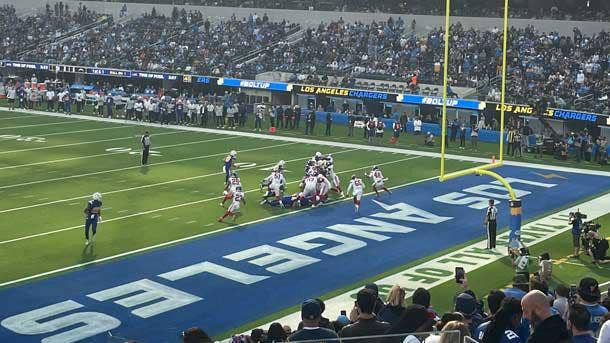
The Stadium
SoFi Stadium resides in Inglewood, California and was built by Los Angeles Rams Owner and Chair E. Stanley Kroenke. The first “indoor-outdoor” stadium, the 3.1 million square foot arena sits in the middle of a 298-acre mixed-use development that includes retail and commercial office space, a hotel, residential units, and outdoor park spaces.
The stadium was built to be state-of-the-art. It‘s 100 percent digital, meaning guests can only show tickets in a mobile format, which adds even more demand to the robust network. SoFi features a massive Wi-Fi 6 deployment, a single, converged network, a modern data center and “command center,” as well as a 70,000-square-foot, 4K Infinity Screen by Samsung that soars about the playing field. The oval-shaped dual-sided display gives attendees a view, no matter where they are seated, and it can display unique or the same content across its panels, including game replays or advertisements.
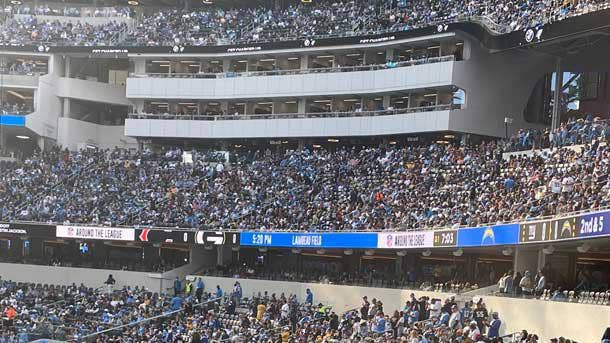
Ampthink On The Job
Technology integrator Ampthink LLC is no stranger to large-scale IT deployments, especially in the sports and entertainment space. The firm got its start building out the entire network for Dickies Arena, a 14,000-seat multipurpose stadium in Fort Worth, Texas. Ampthink built out networks in five to six subsequent arenas in the U.S., and so the firm got involved with SoFi stadium when construction began in 2016, said Bill Anderson, CEO of Ampthink.
Ampthink has worked with only a handful of networking vendors for its stadium practice because there’s only a few that are capable of massive-scale deployments and that are willing to invest in next-generation software capabilities, Anderson said. Ampthink quickly became the premier Cisco Connected Sports Solutions partner in North America.
The scope and size of the SoFi project made the deployment unique right off the bat. Ampthink and the SoFi IT team also knew that they entire campus had to be connected and future use cases had to be anticipated, Anderson said.
“We really just had to tackle more connection points than we‘ve ever had to handle anywhere else,” he told CRN. “It was this idea that we were going to not just build a stadium network, but we had to essentially build a huge enterprise network; what would be a fortune 500 class network, and that was just very different than the typical scope for a stadium.”
To date, there hasn‘t been an IT project at any stadium or arena anywhere in the world that demands the level of integration and sophistication that the SoFi project required, Anderson said. “Whether it’s the video on the roof, or the seismic system that used to monitor earthquakes, to the sprinkler system and so on, everything is plugged into the network,” he said.
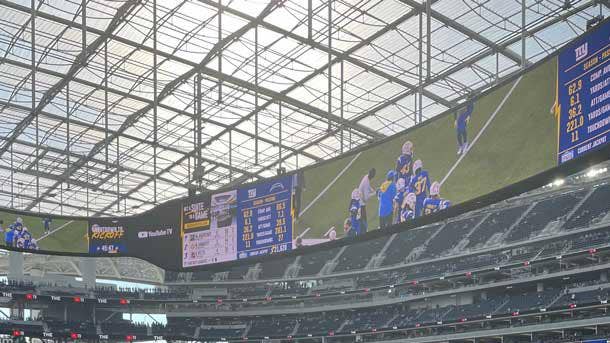
The Wi-Fi
SoFi Stadium currently has the largest Wi-Fi 6 deployment of any sports venue in the world with more than 2,500 Cisco access points and 273 switches spread across the stadium. And that‘s just the arena – the deployment is only increasing from there as more of the campus gets built out, SoFi’s Hedinsson said.
SoFi is powered by Wi-Fi 6 technology, the latest standard so it can serve up the fastest and most reliable possible user experience. Wi-Fi 6 is also more energy efficient and requires less battery power than predecessor technology. The entire stadium runs on one, secure Wi-Fi platform used by employees, operations, and fans. Gear selected for the job was Cisco‘s Catalyst 9K for enterprise switching and routing.
Because of the heavy demand on the Wi-Fi, SoFi needed a highly secure platform system to support the thousands of transactions taking place across numerous points of sale throughout the 300-acre mixed-use property at any given time. There are about 12,000 total active network connections currently on-campus, Hedinsson said.
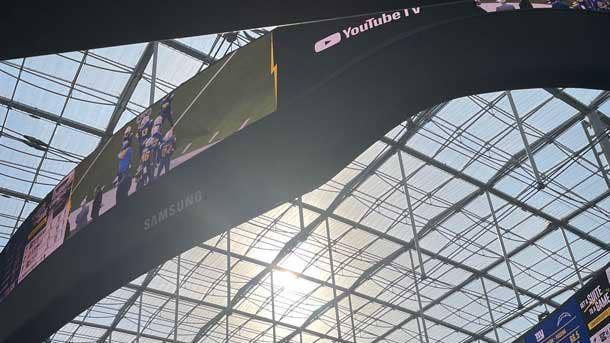
The “Command Center”
The so-called command center, also known as the broadcast room, houses the operators that are busy dynamically programming all 2,000-plus 4k displays throughout SoFi Stadium’s concourses, suites, and concessions, including the 80-million-pixel Infinity Screen by Samsung that hangs over the field showcasing the action on the field, replays, or advertisements.
The operators or showrunners on event or game day can take a customized approach for each screen as desired or needed and the same singular Cisco network connects the building‘s PA system, every screen running IPTV, Wi-Fi, collaboration, and TV broadcast to the command center.
Ampthink built all the networking that connects the world’s largest high-dynamic-range (HDR) network running in the broadcast room, Anderson said. The command center, like the data center environment, is run on Nexus 9000 switches. The command center team also relies on Google Cloud Platform to manage their data workflows and Cisco for its on-premises needs.
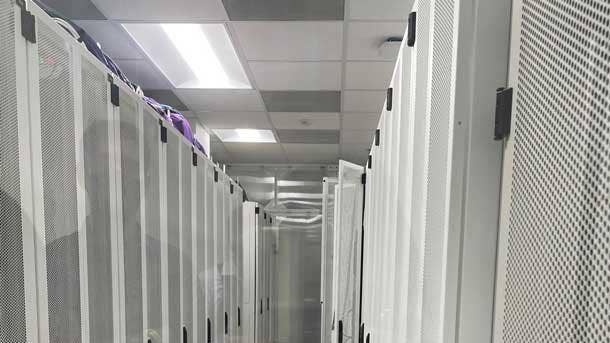
The Data Center
The “real tech story” lives in the data center, said Anderson, because that’s how the SoFi campus is being powered. A single, converged network on which SoFi is built is run by an on-site data center, which was originally designed to hold seven server racks and thousands of servers, but through virtualization and Cisco Hyperflex hyper-converged infrastructure, operations only needed one-half rack holding a few hundred servers to power the entire 300-acre property and all its corresponding applications, Hedinsson said.
The Cisco HyperFlex HX data platform can modernize data centers and power traditional and cloud native applications. It simplifies DevOps enablement and optimizes operations across distributed environments. The data center is powered by Cisco‘s Nexus 9k line for data center and Server Switching.